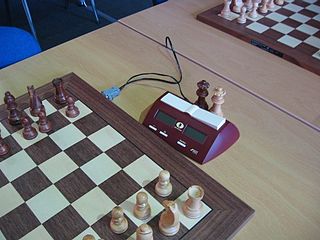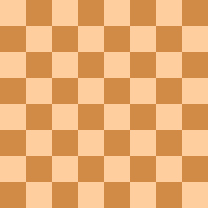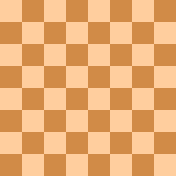Stalemate is a situation in chess where the player whose turn it is to move is not in check and has no legal move. Stalemate results in a draw. During the endgame, stalemate is a resource that can enable the player with the inferior position to draw the game rather than lose. In more complex positions, stalemate is much rarer, usually taking the form of a swindle that succeeds only if the superior side is inattentive. Stalemate is also a common theme in endgame studies and other chess problems.
The Lucena position is a position in chess endgame theory where one side has a rook and a pawn and the defender has a rook. Karsten Müller said that it may be the most important position in endgame theory. It is fundamental in the rook and pawn versus rook endgame. If the side with the pawn can reach this type of position, they can forcibly win the game. Most rook and pawn versus rook endgames reach either the Lucena position or the Philidor position if played accurately. The side with the pawn will try to reach the Lucena position to win; the other side will try to reach the Philidor position to draw.

Checkmate is any game position in chess and other chess-like games in which a player's king is in check and there is no possible escape. Checkmating the opponent wins the game.
The two knights endgame is a chess endgame with a king and two knights versus a king. In contrast to a king and two bishops, or a bishop and a knight, a king and two knights cannot force checkmate against a lone king. Although there are checkmate positions, a king and two knights cannot force them against proper, relatively easy defense.
Triangulation is a tactic used in chess to put one's opponent in zugzwang. Triangulation is also called losing a tempo or losing a move.
In chess, a passed pawn is a pawn with no opposing pawns to prevent it from advancing to the eighth rank; i.e. there are no opposing pawns in front of it on either the same file or adjacent files. A passed pawn is sometimes colloquially called a passer. Passed pawns are advantageous because only the opponent's pieces can stop them from promoting.
The Saavedra position is one of the best-known chess endgame studies. It is named after the Spanish priest Fernando Saavedra (1849–1922), who lived in Glasgow during the late 19th century. Though not a strong player, he spotted a win involving a dramatic underpromotion in a position previously thought to have been a draw.

In chess, promotion is the replacement of a pawn with a new piece when the pawn is moved to its last rank. The player replaces the pawn immediately with a queen, rook, bishop, or knight of the same color. The new piece does not have to be a previously captured piece. Promotion is mandatory when moving to the last rank; the pawn cannot remain as a pawn.
The chess endgame with a king and a pawn versus a king is one of the most important and fundamental endgames, other than the basic checkmates. It is an important endgame for chess players to master, since most other endgames have the potential of reducing to this type of endgame via exchanges of pieces. Players need to be able to determine quickly whether a given position is a win or a draw, and to know the technique for playing it. The crux of this endgame is whether or not the pawn can be promoted, so checkmate can be forced.
In chess, a grotesque is a problem or endgame study which features a particularly unlikely or impossible initial position, especially one in which White fights with a very small force against a much larger black army. Grotesques are generally intended to be humorous.
In chess, a fortress is an endgame drawing technique in which the side behind in material sets up a zone of protection that the opponent cannot penetrate. This might involve keeping the enemy king out of one's position, or a safe zone the enemy cannot force one out of. An elementary fortress is a theoretically drawn position with reduced material in which a passive defense will maintain the draw.
In chess, the bishop and knight checkmate is the checkmate of a lone king by an opposing king, bishop, and knight. With the stronger side to move, checkmate can be forced in at most thirty-three moves from almost any starting position. Although this is classified as one of the four basic checkmates, it occurs in practice only approximately once in every 6,000 games.
The rook and pawn versus rook endgame is a fundamentally important, widely studied chess endgame. Precise play is usually required in these positions. With optimal play, some complicated wins require sixty moves to either checkmate, capture the defending rook, or successfully promote the pawn. In some cases, thirty-five moves are required to advance the pawn once.
Leopold Adamovich Mitrofanov was a Russian chess composer, an International Judge of Chess Composition and an International Master of Chess Composition. He was born in Leningrad and, by profession, was a chemical engineer.
The chess endgame of a queen versus pawn is usually an easy win for the side with the queen. However, if the pawn has advanced to its seventh rank it has possibilities of reaching a draw, and there are some drawn positions with the pawn on the sixth rank. This endgame arises most often from a race of pawns to promote.
The opposite-colored bishops endgame is a chess endgame in which each side has a single bishop and those bishops operate on opposite-colored squares. Without other pieces besides pawns and the kings, these endings are widely known for their tendency to result in a draw. These are the most difficult endings in which to convert a small material advantage to a win. With additional pieces, the stronger side has more chances to win, but still not as many as when bishops are on the same color.
A pawnless chess endgame is a chess endgame in which only a few pieces remain, and no pawns. The basic checkmates are types of pawnless endgames. Endgames without pawns do not occur very often in practice except for the basic checkmates of king and queen versus king, king and rook versus king, and queen versus rook. Other cases that occur occasionally are (1) a rook and minor piece versus a rook and (2) a rook versus a minor piece, especially if the minor piece is a bishop.
In chess, particularly in endgames, a key square is a square such that if a player's king can occupy it, he can force some gain such as the promotion of a pawn or the capture of an opponent's pawn. Key squares are useful mostly in endgames involving only kings and pawns. In the king and pawn versus king endgame, the key squares depend on the position of the pawn and are easy to determine. Some more complex positions have easily determined key squares while other positions have harder-to-determine key squares. Some positions have key squares for both White and Black.

The Réti endgame study is a chess endgame study by Richard Réti. It was published in 1921 in Kagans Neueste Schachnachrichten. It demonstrates how a king can make multiple threats and how it can take more than one path to a given location, using the same number of moves. It is covered in many books on the endgame. The procedure is known as the "Réti Maneuver" or "Réti's Idea". Endgame composer Abram Gurvich called the theme "The Hunt of Two Hares" and it appears in many other studies and games. It is also called "chasing two birds at once".
The queen versus rook endgame is a chess endgame where one player has just a king and queen, and the other player has just a king and rook. As no pawns are on the board, it is a pawnless chess endgame. The side with the queen wins with best play, except for a few rare positions where the queen is immediately lost, or because a draw by stalemate or perpetual check can be forced. However, the win is difficult to achieve in practice, especially against precise defense.






